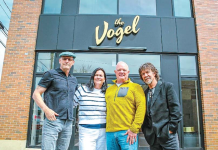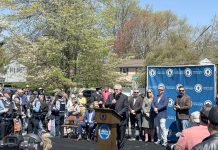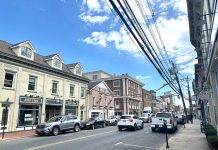By Philip Sean Curran
RUMSON – Early evening had set July 25 when Marian Donohue was getting a crash course on what it means to be a citizen scientist in the cause of saving a river.
The Red Bank resident and about a dozen other people sat inside Bingham Hall listening to representatives of Clean Ocean Action, an environmental group that looks for volunteers to collect water samples mostly from upstream tributaries of the Navesink River.
Alison McCarthy, the coastal watershed protection coordinator for the organization, stood at the front of the room with a long extendable pole in hand demonstrating how volunteers collect samples that later get tested and analyzed by the state Department of Environmental Protection.
Now in its third year, the collection happens every Wednesday morning, rain or shine. Volunteers meet at Count Basie Park in Red Bank and then fan out to the 20 different monitoring sites in Red Bank, Rumson, Fair Haven, Middletown and Tinton Falls.
“This is citizen science,” Swarna Muthukrishnan, a staff scientist with Clean Ocean Action, told the audience. “All of my citizen scientists, I am extremely proud of them. They are the small to the tall. And they all do a very, very fabulous job.”
Testing teams must have at least two members, Muthukrishnan said. They get cooler bags, with ice packs, sterile bottles and other supplies needed for their work.
They’ll go to three to six locations to get samples. McCarthy instructed them about safety steps to take when they are out in the field, like being on the lookout for poison ivy.
The extendable pole is one piece of equipment that volunteers use, made to hold a bottle at one end.
“So you want to sample into the flow,” McCar thy said, using the floor in Bingham Hall as an imaginary body of water. “You do want to fully submerge it.”
As part of their work, volunteers must record where their water samples were collected, who collected them and other data. They also must record the temperature of the water they’re sampling.
“So again, if we’re sampling from a bridge or from a river bank, we need to be able to actually get the water to get the temperature,” McCarthy said.
That’s where buckets with long rope are used, along with thermometers.
Donohue said afterward that she did not know if she could be a volunteer, due to her work schedule.

“If our water is polluted, that’s an issue for overall health,” she said. “But also, you don’t want to live in a community that people say, ‘Well, you have a river there, but it’s polluted and you can’t eat out of it.’ ”
The Navesink, home to shellfish, has a troubled environmental record. In 2015 the state DEP suspended shellfish harvesting in 565.7 acres of the river because of higher than permitted levels of fecal coliform.
The following year, Clean Ocean Action issued a report on the river and formed a coalition of like-minded groups, called Rally for the Navesink. Muthukrishnan said one of the goals of the coalition was to find where the pollution was coming from.
“If the river is polluted, it’s coming from somewhere else,” she said. “So let us go and find the sources of pollution.”
The organization has set a goal of restoring the 565 acres by next year.














